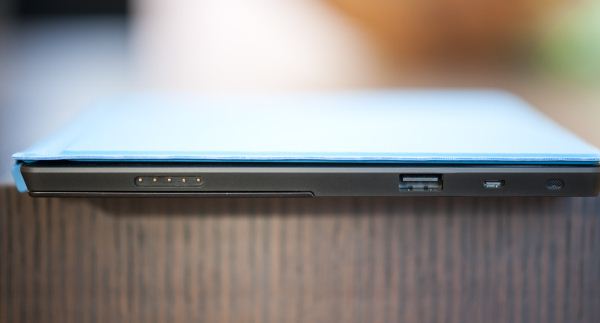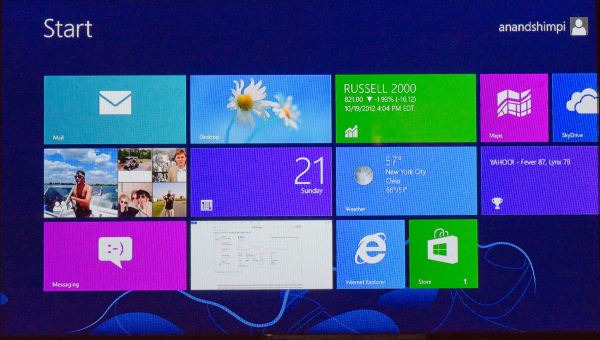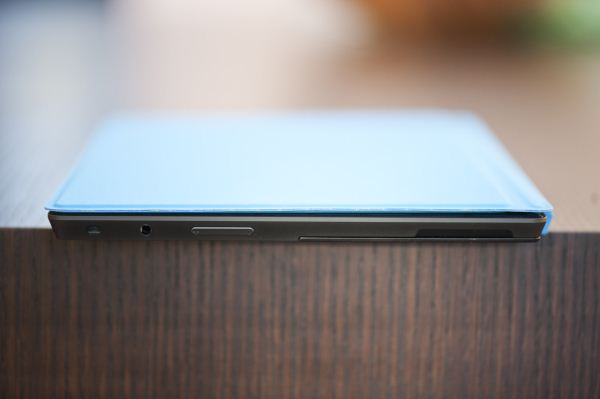Microsoft Surface Review
by Anand Lal Shimpi on October 23, 2012 9:01 PM EST- Posted in
- Tablets
- Microsoft
- Mobile
- Surface
- Windows RT
A Plethora of Ports and Storage Options
One area where Surface is a significant departure from the iPad is in its IO and expansion. The iPad features a single dock (and soon to be Lightning) connector, while Surface looks more like a laptop (or Android tablet) when it comes to IO.
There’s no port for syncing, you get content onto Surface via WiFi or a more traditional method. Surface has a single USB 2.0 port on the right side of the device. You can plug almost anything you want into this port, including USB storage devices of course. Behind the kickstand is a single microSD card slot, giving you another option for expansion.
On the left edge of the device there’s a micro-HDMI out port that can be paired with a Microsoft made VGA or HDMI dongle (both dongles have a 22-degree connector on them to mate flush with Surface). I tested HDMI output with Microsoft's dongle and unfortunately the result wasn't very good. The 1080p output had a lot of issues with scaling quality (as you can see from the shot below) and there was a lot of tearing on the screen with a big impact on UI frame rate. I reached out to Microsoft for an explanation but have yet to hear anything.
Finally there’s a standard 1/8” headphone jack along the top of the device.
Power delivery comes via a custom magnetic connector along the lower right side of Surface.
Given that the internal storage is an eMMC solution, performance from the microSD slot with a good card should be fairly comparable. In practice I could read and write a large sequential file at roughly 10.5 MB/s using a SanDisk microSD card.
Copying from a fast USB stick to Surface’s internal storage gave me transfer rates closer to 17MB/s. There are a few vendors for Windows 8/RT eMMC devices, I’ll be paying close attention over the coming weeks to figure out who makes the best. I know Microsoft and Intel (among others) have been playing close attention to the eMMC providers with hopes of weeding out those that deliver honestly unacceptable performance.
While doing background file IO I didn’t notice any of the stalling/pausing that we’ve seen on some of the more recent Android tablets.
Update: Many have asked about how much storage is taken up by the Windows + Office 2013 installs. The screenshot below shows the directory size for both C:\Windows and C:\Program Files, the latter is where the Office15 install files are included (and yes winword.exe is still the Word executable).
You're looking at roughly 6.47GB for Windows RT and then another 830MB for Office for a grand total of around 7.3GB.
USB Compatibility
Microsoft is particularly proud of its single USB 2.0 port on Surface. Although USB ports have been featured on several Android tablets, their support was typically limited to flash drives, keyboards and mice. With Windows RT, Microsoft wants to bring more of the traditional Windows experience to tablets. Had Surface been x86 based, you would be able to plug in virtually any USB peripheral and it would just work. As the first version of Surface is based on an ARM SoC, driver support is a little more limited but still pretty decent.
USB drives obviously work as you’d expect them to. Even SATA to USB adapters worked fine when plugged into Surface. Other smartphones and tablets also worked, although their level of support varied. For example, you can plug in the iPhone 5 and have it come up as a supported device for moving pictures to/from. However USB tethering is not supported by the class driver included in Windows RT. You can even plug an iPad into Surface and get the same level of support.
Printer support is pretty decent, although the Epson Workforce 910 I tried didn’t actually have specific driver support under RT. Although development for the desktop side of Windows is limited, manufacturers can supply Windows RT drivers to enable support for some more obscure devices. Unfortunately when it comes to those devices you’ll have to play the waiting game as there’s simply not a lot of third party Windows RT drivers available for download today.






_575px.png)








235 Comments
View All Comments
kyuu - Thursday, October 25, 2012 - link
Apple reviews came a week or more after the product was released, not pre-release. Also, they're doing a separate review of WinRT. Unlike Apple, the OS and hardware do not go hand-in-hand (i.e. there are OEMs), so reviewing the hardware and OS separately makes sense.amdwilliam1985 - Tuesday, October 23, 2012 - link
Where is the thumbs up button when you needed one.It's been a while since I've enjoy Anand's writing(too much Apple lately). Read every single word in this great article. My emotion was like a roller coaster reading through the pages. I was sure I'm going to get one at the beginning of the article. And then reading about the "good enough" screen, the power/battery connector, the HDMI port, I was like, maybe next generation. Then moving on with software integration and office, I have my hopes up again. Finally seeing Atom performance preview and the upcoming core x86, I'm definitely holding my horse/breath.
Thanks again for an hour of great reading. I'm in NYC, so I'm planning on seeing the surface on the launch day/evening with my girlfriend.
thomas-hrb - Tuesday, October 23, 2012 - link
I wonder what the maximum size MicroSD card the surface can handle. 32/64 GB is a bit small for a device that I would like to replace my laptop with. But if it could take a 64GB MicroSD like http://au.sandisk.com/products/mobile-memory-produ... then that resolves my issues.Although I intend to hang on for the pro version, as I have a lot oc x86 software I would like to run.
Chris-Simmons - Wednesday, October 24, 2012 - link
All Surfaces use microSDXC so they can take up to 2TB as per the microSDXC spec. I believe the largest microSDXC card available currently is 128GB but that is only for commercial customers, 64GB is the largest for retail. We are just waiting on larger cards to become available.jibz - Tuesday, October 23, 2012 - link
Quick question I didn't see answered in the review: how easy is it to use as a multi user device? One thing that has always bothered me with an iPad or any other tablet is that I can't have different accounts for different family members. So if I install GTA, it'll be available for the kids, I don't have my own bookmarks in my browser, etc. How is Surface/Win RT doing from that point of view?WP7Mango - Wednesday, October 24, 2012 - link
I can give you a detailed answer...Firstly, setting up for multiple users is very easy. The main user is the administrator and the administrator can add further users in the Settings page. Once a user is added, then it's just a case of that new user logging in using either a password, a PIN, or a picture password.
Each user has their own settings, their own apps, their own Start screen layout and background image, their own email accounts, their own contacts in the People hub, their own social network accounts, their own app data, their own bookmarks, etc etc. When one user installs an app, if another user subsequently wants to install the same app then it doesn't get downloaded again - instead, new seperate app settings are created for the new user. So if you are playing a game for example, then your saved games will be seperate from another user's saved games. If you delete a user, only their data is deleted and yours remains intact.
Bottom line is that multi-user works very well.
kyuu - Thursday, October 25, 2012 - link
Thanks for the detailed answer on that!karasaj - Tuesday, October 23, 2012 - link
You mentioned that typing speedily on Surface could bring up some heavy CPU usage: do you think that this really hampers Surface's user experience (would it be an issue) or is it merely an example of MS office 2013 nearly taxing Tegra to its limits?I.E. when typing speedily did CPU usage go up but it remained smooth, or was there a noticeable slowdown? The only things I can imagine doing with Surface are MS office, netflix (HD video), and youtube/IE. Do you think any of those feel too slow/laggy to be detrimental?
VivekGowri - Tuesday, October 23, 2012 - link
Based on my experience with the VivoTab RT (nearly identical hardware/software - Tegra 3 + Windows RT) it's the latter - I saw weirdly high CPU utilization, but no typing lag. Anand mentioned getting some with the Surface, but nothing too drastic if I remember right.karasaj - Tuesday, October 23, 2012 - link
Fantastic. I'm not too worried about high cpu usage as long as there's no lag, although it does seem like that establishes a "lower limit" for RT hardware. Do you think this high cpu usage would have a worse effect on battery life than say the wifi browsing battery life test for example? (I feel like no, but cpu usage shouldn't be too too high there)